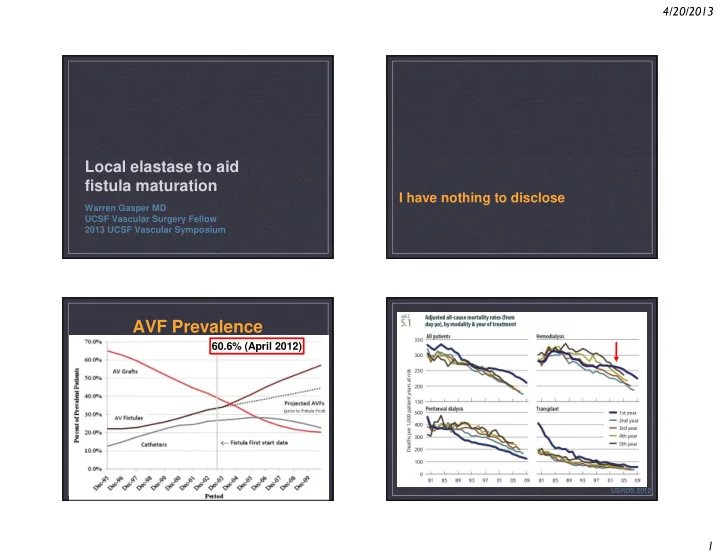

4/20/2013 Local elastase to aid fistula maturation I have nothing to disclose Warren Gasper MD UCSF Vascular Surgery Fellow 2013 UCSF Vascular Symposium AVF Prevalence 60.6% (April 2012) • Fistula First Initiative advocated for a 66% prevalence of arteriovenous fistulas (AVF) for hemodialysis in hopes of reducing infection rates, lowering hospitalization rates, prolonging survival and reducing costs among ESRD patients Vassalotti et al, Semin Dial 2012 USRDS 2012 1
4/20/2013 AVF Prevalence • A higher prevalence of AVFs for dialysis appears to be associated with a reduction in hospitalizations due to access-related infections and a reduction in mortality • However, 60-80% of patients initiate dialysis with a central venous catheter (CVC) • Conversion from CVC to AVF during the first year of dialysis is associated with a significant reduction in mortality (adjusted HR 0.64, 95% CI 0.47-0.87) • The morbidity and mortality of catheters appears to be time-dependent Bradbury et al Am J Kidney Dis 2009; USRDS 2012 Maturation is a physiologic process Factors associated with AVF maturation Fixed Surgeon modifiable Immediate sequelae 10ml/min •Co-morbidities •Experience • Low resistance arterial outflow associated with ESRD •>25 access cases • Increased arterial and venous volume flow •Age •Technique Increased shear stress leads to • •DM •Anastomosis geometry increased endothelial NO •CAD, PAD production and vasodilation •Swing-segment handling 50ml/min •Vein and artery 40-60% AVF diameter maturation •>2mm diameter artery rate •>2.5mm diameter vein 2
4/20/2013 ≥ 500ml/min 10ml/min 4-6 weeks ≥ 550ml/min 50ml/min 50ml/min Intermediate and long-term changes • MMP2/MMP9 production • Remodeling of artery and vein wall with alterations in vascular smooth muscle, collagen, elastin content Sigovan et al, Ann Biomed Eng 2013 The brachial artery • Patients with ESRD have stiff, poorly vasoreactive brachial arteries that frequently contain medial calcifications Sigovan et al, Ann Biomed Eng 2013 Owens J Vasc Access 2011, Sorace J Ultrasound Med 2012, Allon Am J Kidney Dis. 2011 3
4/20/2013 Elastase: alter arterial behavior? • Pancreatic elastase (PRT 201) applied to the vessel adventitia cleaves elastin fibers • Animal models of AVF have demonstrated • Phase I/II dose finding trial of elastase (PRT 201) improved vessel dilation and increased blood applied to the anastomosis in 66 patients flow with a reduction in neointimal hyperplasia undergoing AVF and improvement in AVF patency rates after • No significant adverse events were associated application of PRT 201 with PRT 201 use • No difference in 1 year primary patency rates Peden J Vasc Access 2012 Peden J Vasc Access 2012 Conclusions Factors associated with AVF maturation • AVF maturation is a dynamic physiologic process Fixed Surgeon modifiable that involves remodeling of both the artery and vein but current predictors are weak •Co-morbidities •Experience • Technical factor such as minimum vein and artery associated with ESRD •>25 access cases diameters and intraoperative blood flow are currently •Age •Technique the best predictors of non-maturation •DM •Anastomosis geometry • “ Traditional ” cardiovascular risk factors poorly •CAD, PAD •Swing-segment handling predict maturation, but may be modifiable with novel •Vein and artery therapeutics and a better understanding of AVF Inflammation maturation biology and physiology diameter •>2mm diameter artery •>2.5mm diameter vein Impaired arterial dilation 4
4/20/2013 Targeting the juxta-anastomotic segment • Extra-vascular allogeneic endothelial cells wrapped around juxta-anastomotic segment of AVF (n=31) • Diabetics had significantly less vein dilation at 24 weeks (-0.7mm vs 2.4mm, p<0.002) • Diabetics treated with EC matrix gel had more vein dilation at 24 weeks (+0.6mm vs -1.7mm, p=0.06) JVS 2011 Systematic review of risk factors for fistula non-maturation Relative risk of non- Estimated Estimated maturation (95% CI) Sensitivity Specificity Radial artery 1.5 (0.9 to 2.5) 38% 72% diameter <2mm Cephalic vein 1.9 (1.5 to 2.3) 38% 91% diameter <2mm Intraoperative blood flow 3.5 (2.6 to 4.8) 50% 87% <170ml/min (radial) or <280ml/min (brachial) • Standards for minimum vessel size and minimum intraoperative blood flow have moderate specificity for fistula non-maturation, but poor sensitivity JVS 2009 5
Recommend
More recommend